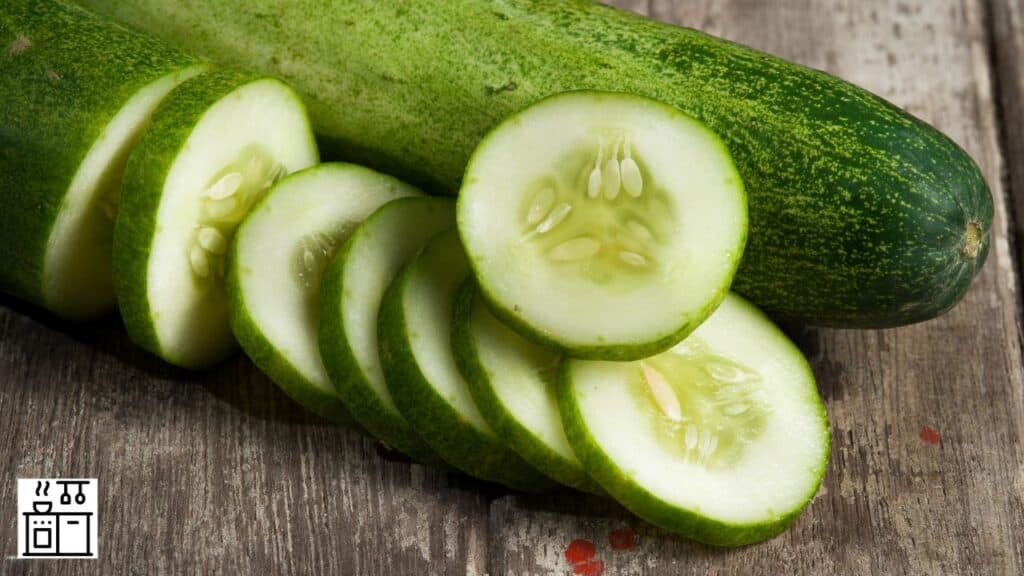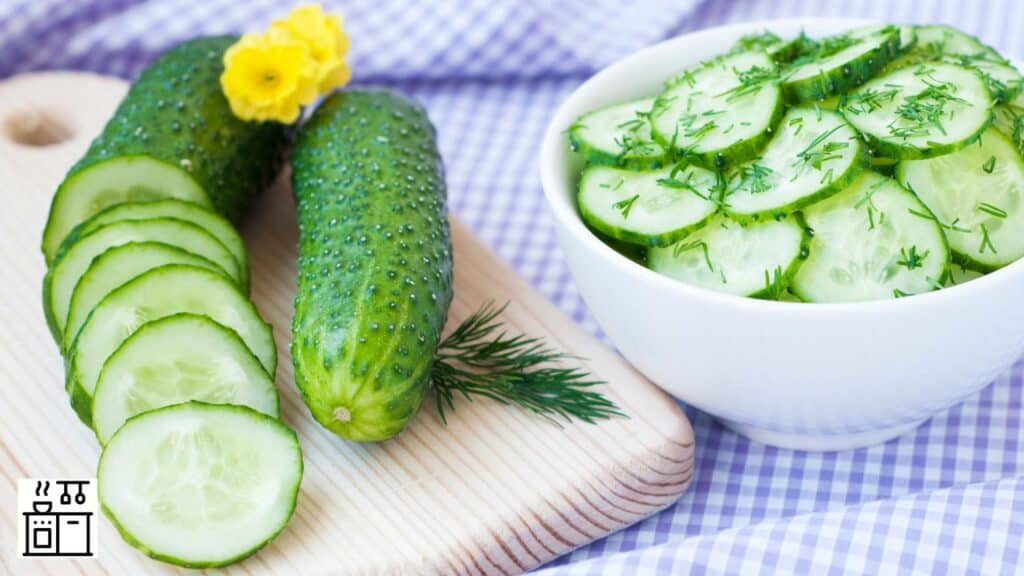Cucumbers and squashes belong to the same family called “Cucurbits.”
So, is cucumber a squash? Let’s find out.
- 10 Reasons Why Cucumber Isn't Squash
- 1. They belong to different species.
- 2. They can't cross-breed.
- 3. Their skin structure is distinct.
- 4. Squashes have the stem attached.
- 5. Squash blossoms are edible.
- 6. Cucumbers are usually green.
- 7. Cucumbers are soft, whereas squashes are hard.
- 8. Cucumbers are more crunchy than squash.
- 9. Cucumbers are good for eating raw.
- 10. The plants look different.
- Takeaway
10 Reasons Why Cucumber Isn’t Squash
Squashes and cucumbers have many common physical traits. However, they are different from each other.
Though cucumbers and squashes are distantly related, certain characteristics distinguish them.
Here are some of the differences between these vegetables.
1. They belong to different species.
Both cucumbers and squashes are cucurbits. They belong to the gourd family.
Interestingly, the Cucurbit plant family has nearly 965 different species.
The members of these different species exhibit certain similarities.
Nevertheless, you can differentiate between them based on their physical and physiological features.
Now, squashes belong to the Cucurbita family. This group includes pumpkins, zucchini, and some gourds also.
Meanwhile, cucumbers belong to the Cucumis species.
Apart from cucumbers, this species also has certain melons and vines.
So, squashes and cucumbers are related but not the same.
2. They can’t cross-breed.
If cucumbers were a type of squash, they would be able to cross-breed with members of the squash family and produce hybrid fruit.
However, this isn’t the case.
If you plant cucumbers and squashes near each other, the flowers on them can’t cross-pollinate.
Hence, you would end up having only cucumbers and squashes, no hybrid fruit.
This factor clearly suggests that they are very distinct from each other and hence can’t produce viable offspring.
3. Their skin structure is distinct.
Physical differences are some of the tell-tale signs to distinguish vegetables.
Let’s look at the outer covering of these vegetables, for instance.
Cucumbers have smooth or bumpy skin, depending on the variety. The skin is thin and easy to peel.
Meanwhile, the outer skin of a squash is thicker. It’s dry and hard.
You will find it more difficult to peel the skin of a squash than to remove the skin of a cucumber.
The thick rind of a squash helps the vegetable stay fresh for longer.
Squashes generally hold up for much longer than cucumbers.
4. Squashes have the stem attached.
Certain members of the squash family, like zucchini, bear striking similarities to cucumbers.
However, there are stark differences in the way the stem attaches to the fruit.
Cucumbers have a barely noticeable stem. Meanwhile, the stem is tightly attached to a squash.
A squash attaches to the vine with a thick and woody stem that creates a visible indent in the skin.
However, cucumbers only have a tiny indent that is barely discernible where it attaches to the vine.
Squashes like zucchinis will also have fine, short hair on their surface. This is absent in cucumbers.
5. Squash blossoms are edible.
Cucumbers and squashes produce flowers. However, these flowers look different.
Cucumber flowers are inedible. They are delicate and fall off the plant easily.
So it’s only the fruit that is available for harvesting.
Squash blossoms are different from cucumbers. Squashes produce more flowers than needed for pollination.
These flowers are large. You can harvest them for culinary purposes.
Squash flowers appear at the base of the stem and are bright yellow. You can use them in different ways.
These flowers are often eaten raw or added to salads.
You can also add them to pizzas, coat them with batter and deep fry them, or bake them into bread.
6. Cucumbers are usually green.

The color of the fruits indicates stark differences between cucumbers and squashes.
Although there are several varieties of cucumbers, they are mostly green.
There are a few cucumber varieties with colors like yellow and white on the skin.
But the common cucumber varieties are mostly green.
Squashes aren’t always green. They usually start as green when they appear on the plant.
However, they can change to other colors like orange, yellow, or even white when they ripen.
Cucumbers are green when they are ripe and ready to consume.
They are ready for harvesting when they just lose the dark green color.
At this stage, the vegetable is most likely bitter.
You should consume them while they are still green in color because they will be over-ripe when they develop a yellow tinge.
7. Cucumbers are soft, whereas squashes are hard.
Both cucumbers and squashes are juicy vegetables.
However, you will notice that they have different textures on the inside.
Cucumbers are soft, and the skin yields to pressure when you push it with your finger.
Squashes, however, are hard. Their skin isn’t at all pliable.
It’s nearly impossible to create any mark on the skin of a squash by pressing them.
They are also strong and warm to the touch, while cucumbers are soft and cool.
8. Cucumbers are more crunchy than squash.
Cucumbers are very crunchy, while squashes aren’t.
When you bite into a cucumber that is just ripe, it has a refreshing coolness. It’s also crunchy and has a good bite.
However, squashes lack crunch. They have thick and hard flesh.
They have a creamy and heavier texture than cucumbers.
You will also find that it doesn’t have the cooling effect of a cucumber when you eat it raw.
It’s one of the main reasons why cucumbers are eaten raw.
The texture of a squash isn’t crunchy and doesn’t taste good when eaten raw.
Related Reading: 8 Tips to Store Cut Cucumber Properly
9. Cucumbers are good for eating raw.
Cucumbers are harvested when they are just ripe because they have the best bite at this stage.
This vegetable is rarely cooked. It’s usually enjoyed raw for its cool and refreshing bite.
Cucumbers are usually added to salads or sandwiches. Another way to enjoy cucumbers is in pickles.
They are either pickled whole or sliced and pickled with flavoring agents like garlic, dill, and chillies.
Cucumbers remain crunchy even when put in brine.
However, squashes are rarely eaten raw. Their texture and flavors aren’t very enjoyable in the raw form.
They are instead cooked or baked to bring out their flavors.
You can roast, grill, steam, or use a variety of other cooking methods to prepare squashes.
They taste milder than cucumbers.
When you cook squash, it will release some liquid.
Nevertheless, these vegetables hold their shape while cooking.
Cucumbers have more water, and they wilt and become mushy when exposed to heat.
10. The plants look different.
If you observe cucumbers and squashes on their vines, they display several differences.
Cucumbers hang from the vines like grapes. Meanwhile, squashes protrude out of the stems of the plant.
They are attached firmly by thicker stems, while cucumbers have delicate stems.
How the vines spread also indicates differences between these plants.
Squashes have thick and strong tendrils that attach strongly to different surfaces.
Meanwhile, cucumbers have delicate and thin tendrils with a looser grip.
Takeaway
The term “squash” doesn’t refer to a specific vegetable, but it’s the common term for a group of vegetables, including zucchini and butternut squash.
These vegetables share various similar characteristics like thick outer skin and high moisture content.
Although cucumbers resemble all the vegetables that belong to the group called squashes, they aren’t squashes.

